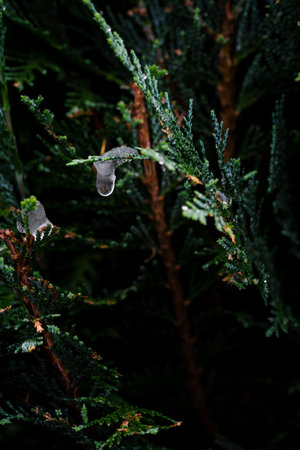Understanding Winter Winds in American Gardens
As winter settles across the diverse landscapes of the United States, gardeners from New England to the Pacific Northwest face a common challenge: the relentless force of winter winds. These gusts, whether icy and dry or damp and biting, can dramatically alter your outdoor spaces. In American gardens, winter winds don’t just chill the air—they draw moisture from plant leaves, erode topsoil, and transform once-protected garden nooks into exposed microclimates. The effects ripple through every layer of your landscape. Evergreen hedges might brown at their tips, delicate ornamentals can suffer windburn, and even hardy native plants are tested by repeated exposure. Furthermore, soil structure is often compromised as strong winds whisk away precious topsoil or compact exposed beds, making it harder for roots to breathe and absorb nutrients. Recognizing these impacts is essential for any gardener who dreams of a thriving four-season landscape. By understanding how winter winds interact with your specific region—whether you’re battling Arctic blasts in the Midwest or swirling Chinook gusts in the Rockies—you’ll be better prepared to protect your garden’s beauty and resilience all year long.
Choosing the Right Windbreaks and Barriers
When it comes to shielding your garden from harsh winter winds, selecting the right windbreaks and barriers is essential. American yards offer diverse landscapes, so it’s important to choose solutions that not only protect but also complement your space aesthetically. There are two main approaches: natural windbreaks, such as evergreen trees and dense shrubs, and structural barriers like fences and garden walls. Each has unique benefits and can be tailored to suit your garden’s specific needs.
Natural Windbreaks: Evergreen Trees and Shrubs
Evergreen trees and shrubs are a popular choice for many American gardeners because they retain their foliage year-round, providing continuous protection from chilling gusts. Species such as Eastern White Pine, Blue Spruce, and Arborvitae are especially effective in colder climates, while Hollies and Junipers add both function and beauty across various regions. Planting these in staggered rows or clusters increases their efficiency as a wind buffer, while also enhancing your garden’s privacy and visual appeal.
Structural Solutions: Fences and Garden Walls
For those seeking immediate results or with limited planting space, structural barriers offer robust protection against winter winds. Solid wood fences, vinyl panels, and stone or brick garden walls can all serve as formidable shields. In suburban American neighborhoods, lattice fencing topped with climbing vines strikes a harmonious balance between structure and nature—offering wind resistance without feeling overly imposing. Consider matching materials and styles to your home’s architecture for an integrated landscape design.
Comparison of Windbreak Options
| Type | Benefits | Best For | Considerations |
|---|---|---|---|
| Evergreen Trees & Shrubs | Year-round coverage; natural aesthetics; habitat for wildlife | Larger yards; long-term investment; blending with landscape | Takes time to mature; requires regular maintenance |
| Wooden/Vinyl Fences | Immediate barrier; customizable height/style; low maintenance | Small to medium yards; quick results; defined boundaries | May need permits; less ecological value than plants |
| Garden Walls (Stone/Brick) | Durable; excellent wind protection; adds property value | Permanent solution; classic or formal gardens | Higher initial cost; professional installation recommended |
| Lattice with Vines | Moderate wind reduction; blends structure with greenery | Cottage gardens; decorative accents; partial screening | Vines need time to establish; not as solid as other barriers |
No matter which option you choose, remember that the most effective windbreaks often combine both natural plantings and structural elements. This layered approach creates a more comfortable microclimate in your yard while maintaining a beautiful American landscape that stands strong through winter’s chill.

3. Designing for Beauty and Functionality
When it comes to shielding your garden from harsh winter winds, the key is to create windbreaks that don’t just serve a practical purpose but also elevate your landscape’s overall charm. The best windbreaks blend seamlessly with your garden, offering protection while adding layers of visual interest throughout the year. Start by choosing plant varieties with appealing forms, textures, and seasonal color changes—think evergreens like American holly or eastern red cedar for year-round structure, or ornamental grasses that sway gracefully even in winter breezes.
Blending Structures into the Landscape
If you opt for fences or trellises as barriers, consider materials and designs that echo your home’s architectural style and the natural surroundings. Wooden lattice panels can be softened with climbing vines such as clematis or native honeysuckle, creating living walls that change with the seasons. Position these barriers in staggered or curving lines rather than straight rows to mimic natural wind patterns and avoid a rigid look.
Layering for Depth and Interest
A well-designed windbreak uses a layered approach: tall trees or structures at the back, medium shrubs in the middle, and lower-growing plants up front. This not only breaks the wind more effectively but also adds depth and complexity to your garden design. Native shrubs like viburnum or serviceberry provide wildlife habitat and seasonal blooms, while lower groundcovers keep the planting beds lush and cohesive.
Functional Features with Artistic Flair
Don’t forget to incorporate functional art elements—such as decorative screens, stone walls, or sculptural trellises—that serve as wind barriers while acting as garden focal points. Painted metal panels with cut-out motifs can cast playful shadows across the snow, bringing artistry to utility. By thoughtfully combining living and built elements, your windbreaks will protect your garden and create a welcoming outdoor haven no matter how brisk the winter winds may blow.
4. Placement Strategies for Maximum Protection
When it comes to shielding your garden from winter winds, strategic placement of windbreaks and barriers is essential. Understanding regional weather patterns across the United States can help you position these structures for optimal protection. Prevailing wind directions vary based on geography, so tailoring your approach ensures your garden stays sheltered all season long.
Know Your Regional Winds
The first step in planning effective windbreak placement is identifying where harsh winter winds typically come from in your area. For example, in the Midwest and Great Plains, prevailing winds often blow from the northwest during winter. In coastal areas, winds may shift more frequently but are commonly from the north or northeast.
Regional Wind Direction Guide
| Region | Typical Winter Wind Direction | Recommended Windbreak Placement |
|---|---|---|
| Northeast & Mid-Atlantic | North/Northwest | Along northern and western property lines |
| Southeast | North/West | On north and west sides of garden |
| Midwest & Plains | Northwest/West | Across northwest perimeter of garden or yard |
| Mountain West | Varies (often West/North) | Assess local microclimate; generally on west/north sides |
| Pacific Northwest | East/Northeast (occasionally West) | Place on east/northeast side, monitor for shifting winds |
| Southwest & California Coast | North/East (can vary) | Northern or eastern boundaries, consider elevation changes |
Tips for Effective Windbreak Positioning
- Height Matters: The taller your barrier, the further downwind it will protect. Aim for a windbreak at least as tall as the plants you wish to shield.
- Create Overlap: If using multiple barriers, stagger them to eliminate gaps where wind can funnel through.
- Avoid Solid Walls: Permeable barriers like hedges or louvered fences slow wind without creating damaging turbulence behind them.
- Distance from Plants: Place windbreaks two to five times their height upwind from sensitive plantings for best results.
Aesthetic Integration with Landscape Design
Select materials and plantings that complement your overall landscape style—evergreen hedges, ornamental grasses, or rustic wood panels add both visual interest and practical function. Thoughtful placement not only protects your garden but enhances its year-round beauty.
5. Maintenance and Seasonal Care Tips
Once you’ve invested in windbreaks and barriers to protect your garden from winter’s harsh winds, regular upkeep is the secret to ensuring these defenses remain both beautiful and effective throughout the season. Whether you’ve chosen living hedges or constructed fences, each element of your wind protection strategy needs attention tailored to its unique qualities.
Living Windbreaks: Nurturing Nature’s Shield
For living windbreaks—such as evergreens, dense shrubs, or ornamental grasses—consistent care is key. Before winter sets in, prune dead or damaged branches to reduce breakage under heavy snow or ice. Mulch around the base with organic material like shredded bark or leaves; this not only insulates roots against temperature swings but also helps retain soil moisture through dry winter winds. Water your plantings deeply during fall if rainfall has been scarce, as hydrated plants withstand cold stress better. Inspect for signs of disease or pests, since weakened plants are more vulnerable to wind damage.
Built Barriers: Ensuring Structural Integrity
If you rely on fencing, trellises, or temporary burlap screens, a seasonal inspection should be part of your winter preparation ritual. Check for loose posts, rusted hardware, or torn fabric. Tighten, repair, or replace any compromised parts before storms arrive. For wooden structures, consider applying a weather-resistant sealant to guard against moisture and freezing temperatures that can cause warping or cracking. If using movable barriers, store them securely when not in use to prolong their lifespan.
Adapting to Local Conditions
Every American garden faces its own regional challenges—from the salty breezes of coastal Maine to the biting prairie gusts of the Midwest. Stay mindful of how snow accumulation and prevailing wind directions shift year-to-year. Adjust your maintenance routine accordingly: shovel away drifting snow from barrier bases and trim back overhanging limbs after heavy storms. Your vigilance ensures windbreaks continue to serve as reliable sentinels for your landscape.
A Season-Long Commitment
By giving thoughtful care to both living and built windbreaks, you not only shield your garden beds but also enhance their visual charm through the coldest months. This commitment extends your garden’s vitality into spring—when fresh growth will thank you for the protection provided all winter long.
6. Eco-Friendly and Native Choices
When designing windbreaks for your garden, choosing eco-friendly and native options isn’t just a sustainable approach—it’s also an investment in the vitality of your outdoor space and local biodiversity. By prioritizing native plants for your windbreaks, you create a living barrier that is naturally adapted to your region’s climate, soil, and wildlife. These plants require less water and maintenance, making them a smart choice for gardeners who want beauty without excess upkeep.
Native Plants: A Natural Fit
Native species like American holly, Eastern red cedar, or switchgrass offer strong resistance to winter winds while providing habitat and food for birds and pollinators. Unlike imported varieties, they thrive with minimal intervention and seamlessly blend into the landscape, preserving the authentic character of your garden.
Sustainable Materials Matter
If you opt for structural barriers—such as fences or screens—select materials with a low environmental impact. Reclaimed wood, recycled metal, or composite lumber are durable choices that reduce waste. Pairing these materials with living plantings creates layered protection that looks natural and supports ecological health.
Supporting Local Ecosystems
By using native plants and sustainable materials, you’re not only safeguarding your garden from harsh winter winds but also nurturing the broader ecosystem. These thoughtful choices encourage healthy soil microbes, attract beneficial insects, and contribute to a resilient landscape that endures season after season. Ultimately, your windbreak becomes more than just a shield—it transforms into a thriving part of the environment that benefits both your home and your community.


